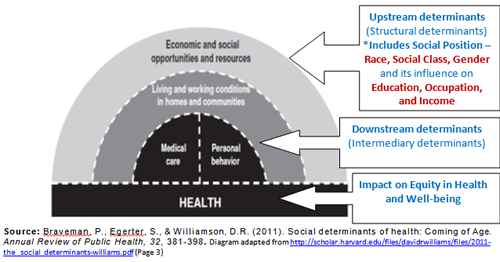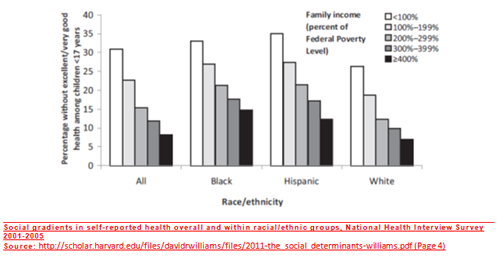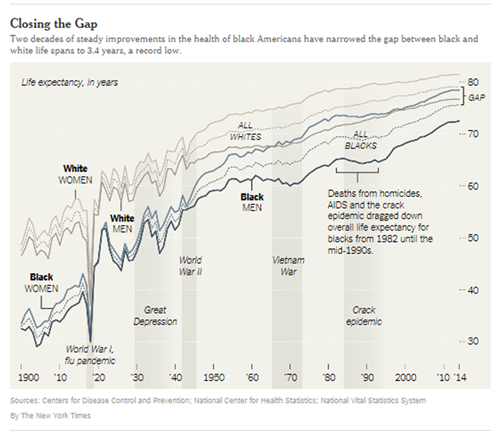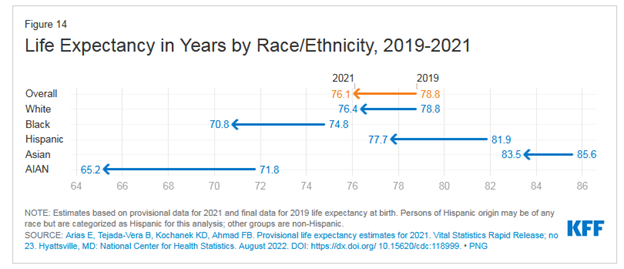Online Course
NRSG 780 - Health Promotion and Population Health
Module 6: Social Justice and the Social Determinants of Health
Health Inequities and Racial Injustice
Understanding Social Factors And Social Context In Shaping Health
Social determinants of health are factors that play a fundamental causal role and represent important opportunities for improving health and reducing health disparities.
The following figure is a conceptual framework on the social factors that shape health. It shows that health related personal behaviors and receipt of recommended medical care (i.e., key downstream determinants of an individual’s health) do not occur in a vacuum. These factors are shaped by key upstream determinants related to the living and working conditions, and even more by economic and social opportunities and resources. Key upstream determinants include:
- Neighborhood conditions and health
- Working conditions and health
- Education and health
- Income, wealth and health (social position)
- Race, racism and health (social position)
- Gender and health (social position)

Social Advantage or Disadvantage refers to the relatively favorable or unfavorable social, economic, or political conditions that some groups systematically experience based on their relative position in social hierarchies. (Braverman et.al., 2011).
Social Gradients in Health refers to stepwise patterns in income, education, or occupational grade that reflect relatively direct health outcomes (Braverman et.al., 2011). For example, more economic resources and income relate to healthier nutrition, housing, and less stress due to more resources and assets to cope with daily challenge.

Economic Inequality Affects Health in Three Main Ways
- Economically unequal societies have greater levels of poverty
- Economically unequal societies provide fewer social safety nets
- Economically unequal societies have weaker social cohesion
Click here to watch and listen to Dr. Jeffrey V. Johnson, discuss “Health Inequities and the Social Class Gradient”
Click here for a copy of the powerpoint that accompanies the presentation.
Exercise
After watching the following brief video (2:31) on the Social Determinants of Health, take a moment to reflect on the questions listed below.
- How did this brief video convey the key concepts related to the Social Determinants of Health? Describe their social advantages and disadvantages.
- Based on the information provided, describe what you imagine the health status of each character (Chad and Jeff) to be? How would they compare to each other? Why? What types of health issues might Chad and Jeff have encountered as boys? What types of health issues might be expected to develop for Chad and Jeff as they age?
- How different would the health outcomes of Chad and Jeff be if they were a different race? A different gender? From a different geographic location than what you may have imagined?
- How could being aware of the social factors and conditions of Chad and Jeff change or influence the way you would interact with them in a healthcare setting?
A Closer Look at One Upstream Determinant: Racial Injustice and Health Inequities
“Contextualizing Risk Factors”
- How do people come to be exposed to individually-based risk factors (diet, cholesterol, lack of exercise, high blood pressure, smoking, etc…)?
- What is it about people’s lives that shape their exposure to individual risk factors?
- What is the social process that leads to exposure?
Social Determinants are linked to health through complex causal chains
- “Recognizing the causal chains is crucial to recognizing the injustice in the current state of health and longevity of human beings in modern societies.” ~Sridhar Venkatapuram,

Racial disparities in health exist.
Some social policies within the United States have served to discriminate against minorities by limiting educational and occupational advancement, denying access to community and social services, and segregating communities. These long-term structural determinants of health have impacted the health outcomes of generations of the population. African-Americans suffer a much greater burden of disease compared to whites. The relative risk of mortality for African-Americans is higher than that for whites for all ages under 85. Causes of excess death include:
- Heart disease and stroke
- Homicide and injuries
- Cancer
- COVID
- Infant mortality
- Cirrhosis
- Diabetes
- HIV/AIDS
Racism is one of the primary structural determinants behind racial disparities in health because it changes the “Risk Profile” of groups and leads to differences in exposure to:
- Stress
- Hazardous environments
- Restriction of opportunities
- Adverse health behaviors
The gap in life expectancy between Black and White Americanswas narrowing for a variety of reasons until the COVID pandemic. The rates of homicide, cancer and infant mortality has declined at a faster rate in Blacks than Whites. Life expectancy also has been decreasing faster for Whites than Blacks as a result of the opioid crisis. However, the burden of COVID has disproportionately resulted in increased mortality among Black, Hispanic, Asian, and AIAN Americans. In 2019 the mortality gap between black and white Americans was 4 years. In 2021, the mortality gap increased to 5.6 years.

Source http://www.nytimes.com/2016/05/09/health/blacks-see-gains-in-life-expectancy.html?_r=0

https://www.kff.org/racial-equity-and-health-policy/report/key-data-on-health-and-health-care-by-race-and-ethnicity/ (March 15, 2023)
This website is maintained by the University of Maryland School of Nursing (UMSON) Office of Learning Technologies. The UMSON logo and all other contents of this website are the sole property of UMSON and may not be used for any purpose without prior written consent. Links to other websites do not constitute or imply an endorsement of those sites, their content, or their products and services. Please send comments, corrections, and link improvements to nrsonline@umaryland.edu.